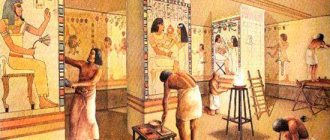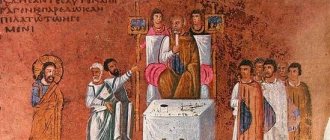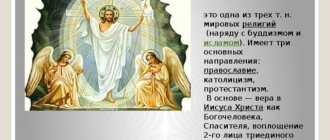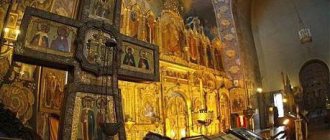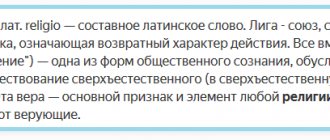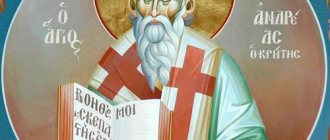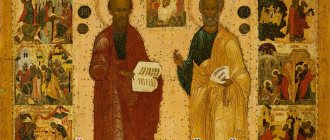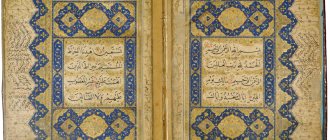What books contain church canons?
The main canonical body of the Orthodox Church is contained in a collection with the title “Book of Rules” (full title: Book of Rules of the Holy Apostles, Holy Councils of Ecumenical and Local Councils, and Holy Fathers). The helmsman's book (Nomocanon) is a collection of ecclesiastical and secular laws that served as a guide for the administration of the Church and in the ecclesiastical court of Orthodox Slavic countries.
How do canons differ from dogmas?
In contrast to the dogmas in which the doctrine of the Church is formulated, the canons define the norms of church life.
There may be cases where the Church edits its own canons, which is completely impossible with regard to dogmas. We can say that if dogmas tell us what really exists, then the canons tell us how convenient it is for the Church to exist in the conditions of the earthly world after the Fall.
How to read an akathist to St. Nicholas the Wonderworker
Before committing to reading an akathist to a saint for a certain period of time, it is better to take a blessing from your confessor. The priest performing the sacrament of confession, knowing the spiritual powers, life circumstances and internal state of the believer, will bless or give advice to postpone reading for now.
There are certain rules for reading the akathist. The thirteenth kontakion - a prayer appeal to the saint - is read three times. After the last kontakion of the akathist, the first ikos and kontakion are read again. Then a prayer is read to St. Nicholas the Wonderworker.
The number of days during which the akathist is read is unlimited. The Akathist can be read at any convenient time. It is better if during this time an icon of the saint is located nearby.
Often the hymn of praise is recited over a period of forty days. At the same time, if you had to skip a day, you can continue the next one.
You can read the akathist to St. Nicholas the Wonderworker just once, the main thing is to feel in your soul the desire and desire to turn to the saint. An akathist is equivalent to a hymn, so it is better to stand when reading it.
How to correctly understand and apply church canons?
When trying to apply church canons to modern circumstances, it is necessary to take into account mens legislatoris - the intention of the legislator, i.e. the meaning, historical and cultural aspects originally put into the canon.
“In order for a person to correctly apply church canons for the benefit of people, he must be spiritual and have spiritual reasoning. Because otherwise he remains on the letter of the law, and the letter of the law “kills.” The man is telling you. “It’s written like this in the Helmsman,” and he applies it literally as he sees it in the book, but he should analyze each case separately. As I have seen in practice, one case can hide thousands of other cases. There is no one recipe, one single rule for all occasions.” Venerable Paisius of Athos
Saint Nicholas the Wonderworker
Saint Nicholas the Wonderworker was born in 270 in the city of Patara, Lycia province. From a young age he was distinguished by his piety and desire to serve God. As a priest, the saint set an example for his flock, preaching, admonishing and directing the inhabitants of Lycia on the path of salvation. After several years of serving as a priest, Saint Nicholas was elected Bishop of Myra in Lycia.
The asceticism of Saint Nicholas took place during the period of persecution of Christianity. When the bishop, together with other Christians, was imprisoned, the saint not only courageously endured all the hardships and hardships, but also supported the rest of those imprisoned.
Even during his lifetime, Saint Nicholas was credited with many miracles and acts of true mercy and love for one’s neighbor. Saint Nicholas the Wonderworker is revered in both Western and Eastern Christianity. This saint is especially loved by believers, and many people turn to him in prayer.
What is the task of church canons?
The main task of church canons is the application of the unchanging and eternal infallible foundations of Christian moral teaching and ecclesiological dogmas, contained either directly or indirectly in their texts, to the changing church life. Therefore, in any canon one can find, on the one hand, rooted in the unchangeable dogmatic teaching of the Church, and on the other hand , conditioned by a historically specific situation, the circumstances of church life that took place at the time the canon was published and could subsequently change. Thus, the basis of every canon contains an unchanging, dogmatically determined moment, but in its concrete and literal sense the canon also reflects the transitory circumstances of church life.
Canon to Nicholas the Wonderworker
The canons to St. Nicholas the Wonderworker are works of church hymnography, complex in structure, praising the saint. Their text consists of biblical chants, to which additional verses were later added - irmos and troparia. The latter glorify the festive event. Irmos serve to connect the biblical song and troparion, drawing an analogy between the celebrated event and that described in the Bible. The structure of the irmos is the basis for the melody and rhythmic structure of the troparion. The length and number of stanzas must match.
There are several canons to the saint:
- “In the depths of the bed sometimes.....” is the beginning of the irmos of the first canon.
- The 2nd canon to St. Nicholas the Wonderworker begins with the irmos “Christ is born - glorify...”
- “Let us sing a song, people...” - the irmos of the canon from the service for the transfer of the relics of the saint.
- “I will open my mouth...” - the beginning of the fourth canon to St. Nicholas the Wonderworker.
Canon 2 to St. Nicholas the Wonderworker, like Canon 1, is read during the service on the saint’s feast day, December 19, according to the new style. The other two canons are read at the service on the day of remembrance of the transfer of the relics of the saint on May 22.
Can this or that church canon not be used?
The canon may become inapplicable due to the disappearance of the church institution that it regulates. For example, Chalcis. 15 determines the age limit for becoming a deaconess - 40 years. With the disappearance of the order of deaconesses, the rule ceased to apply. Nevertheless, it remained in the canonical corps. Moreover, it now contains a certain ecclesiological principle, which has not lost its practical significance due to the disappearance of the institution of deaconesses. For example, it can serve as a starting point in the reasoning of church authorities about establishing an age limit for appointing women to any church positions. Some canons have the character of private definitions, and therefore, according to the literal text, they are not applicable in any other cases except those for which they were published, such as II Omni. 4 (“About Maximus Cynicus, and about the outrage he caused in Constantinople...”).
Why read an akathist to St. Nicholas the Wonderworker?
The Akathist, like the canon to St. Nicholas the Wonderworker, helps believers in a variety of cases. A prayerful appeal to the saint helps with any difficulties. You can find many grateful reviews and real stories from the lives of people telling about the resolution of difficult life circumstances after prayers to the saint. People turn to him especially often in case of illness, financial and domestic difficulties, or while traveling. Even during his lifetime, Bishop Myra of Lycia provided assistance to many in need.
The text of the akathist contains biographies of the saint. Many people perceive it much easier than the canon to St. Nicholas the Wonderworker.
You should not treat the reading of the akathist as a magical rite or conspiracy. Desire for quick results will not bring any benefit. The main feeling when turning to a saint should be repentance and faith that the Pleasant of God will hear the request and help.
What is the composition of the canonical corps of the Orthodox Church?
The canonical corps of the Orthodox Church was formed in the 9th century, under St. Photius I, Patriarch of Constantinople. It included 85 Apostolic Rules, 20 rules of the First Ecumenical Council (325), 7 of the Ecumenical II Council (381), 8 of the III Ecumenical Council (431), 30 of the IV Ecumenical Council (451), 102 of the Trullo Council (691 - 692), 22 rules of the VII Ecumenical Council (787), Canons of Local Councils: Ancyra (314) – 25, Neocaesarea (between 314 and 325) – 15, Gangra (c. 340) – 21, Antioch (341) – 25, Laodicea (c. 343) – 60, Sardician (343) – 20 (according to another numbering – 21), Constantinople (394) – 1, Carthaginian (419) – 133 (according to other numbering – 147), Constantinople Double (861) – 17, Constantinople in the Church of St. Sophia (879) – 3; rules of the Church Fathers: 4 rules of St. Dionysius the Great, bishop. Alexandria, 11 (according to another numbering - 12, the first rule is divided into 2) - St. Gregory the Wonderworker, 15 – sschmch. Peter I, Archbishop of Alexandria, 3 – St. Athanasius I the Great, 92 – St. Basil the Great, 18 – Timothy I, Archbishop of Alexandria, 1 – St. Gregory the Theologian, 1 – St. Amphilochius, Bishop of Iconium, 8 – St. Gregory, Bishop of Nyssa, 14 - Theophilus, Archbishop of Alexandria, 5 - St. Cyril, Archbishop of Alexandria, 1 – St. Gennady I, Patriarch of Constantinople, and 1 – St. Tarasius, Patriarch of Constantinople. As an appendix, some editions of the code of canons also include the resolution of the Council of Carthage in 255, held under the chairmanship of the schemm. Cyprian, on the rebaptism of heretics and the rules of the Patriarchs of Constantinople, St. John the Faster, St. Nikephoros I Confessor and Nicholas III Grammar, not included in the canonical corpus.
***
Protopresbyter Nikolai Afanasyev began his course on canon law with these words: “Gentlemen, students! I have been instructed to read to you a subject that is usually called “canon law,” although I must tell you right away that such a name is a misunderstanding, because law itself has no place in the Church. Law penetrated into the Church only when love became scarce.”
***
A brief summary of the canonical definitions of the Ecumenical Councils
The First Ecumenical Council in Nicaea in 325 left us 20 rules:
The first rule prohibits the admission into the clergy of persons who have castrated themselves;
The second rule prohibits the promotion of converts to the sacred degrees;
Rule three prohibits clergy from having in their house a woman who is not a close relative;
Rule four states that bishops must be elected by the bishops of a given region and approved by the metropolitan;
The fifth rule prohibits a bishop from accepting into communion persons excommunicated by another bishop and commands that councils of bishops be convened twice a year;
Rule six confirms the supreme authority of some bishops over other bishops and prohibits the appointment of a bishop without the consent of the metropolitan and general election;
Rule seven elevates the bishop of Jerusalem to the rank of metropolitan;
The eighth rule provides for the accession of heretics to the Church and prohibits two bishops from being in the same city;
Rule nine prohibits the admission of vicious persons to the priesthood;
The tenth rule commands the casting out of the sacred order of the fallen;
Rule eleven speaks about the method of repentance for those who have departed from the faith;
The twelfth rule also speaks of the image of repentance of another type of fallen ones;
Rule thirteen commands us to admonish the Holy Mysteries to every dying person;
Rule fourteen establishes an image of repentance for catechumens who have fallen from the faith;
Rule fifteen prohibits bishops and clergy from moving from city to city without permission;
Rule sixteen prescribes not to accept into communion clergy who voluntarily remove themselves from their own church;
Rule seventeen prohibits clerics from engaging in usury;
Rule eighteen forbids deacons to teach St. Gifts to presbyters, to receive communion before bishops and to sit between presbyters;
The nineteenth rule says about the “peacocks” that they, in the event of their conversion, must be re-baptized, and the clergy re-ordained;
Rule twentieth prohibits kneeling on Sunday and Pentecost.
The Second Ecumenical Council in Constantinople in 381 left behind only seven rules:
The first rule confirms the Creed, compiled at the First Ecumenical Council and anathematizes all heresy;
The second rule prohibits bishops from extending their power “outside their area”, from interfering in the affairs of another’s diocese, and establishes 5 church districts in the East;
The third rule gives the Bishop of Constantinople "the advantage of honor over the Bishop of Rome";
Rule four condemns Maxim Kinik and “the outrage he caused”;
The fifth rule accepts “those who confess One Divinity of the Father and the Son and the Holy Spirit”;
Rule six commands “not without investigation” to accept accusations against the rulers of the Church;
Rule seven indicates the rules for accepting repentant heretics.
The Third Ecumenical Council, held in Ephesus in 431, left eight rules:
The rules - first, second, third, fourth, fifth and sixth - all relate to the excommunication of the heretic Nestorius and his supporters;
Rule seven prohibits the creation of any new Creed;
The eighth rule prohibits bishops from “extending their power to another diocese, which was not before and at first under his hand” and frees the Cypriot bishops from the dependence of the Patriarch of Antioch.
The IV Ecumenical Council, convened in Chalcedon in 451, left behind 30 rules. From these rules:
The first rule confirms the need to observe everything that was decreed at previous councils;
The second rule punishes simony, or placement in church ranks for money, by dethronement;
Rule three prohibits bishops, clergy and monastics from engaging in “worldly affairs” “for the sake of vile profit”;
Rule four prohibits monks from living disorderly;
Rule five confirms the prohibition for bishops or clergy to “move from city to city”;
Rule six prohibits the ordination of clergy without a specific appointment;
Rule seven prohibits clerics and monks, under threat of anathema, “to enter into military service or secular rank”;
The eighth rule commands the clergy to remain “under the authority of the bishops of each city”;
Rule nine prohibits clergy from suing in secular courts;
Rule ten prohibits a cleric from being registered in two churches at the same time;
Rule eleven speaks of certificates issued to the poor;
The twelfth rule prohibits bishops from referring to civil authorities in ecclesiastical matters;
Rule thirteen prohibits clergy from serving in a foreign diocese without a representative letter from their bishop;
Rule fourteen prohibits readers and singers from marrying wives of other faiths;
Rule fifteen speaks of the appointment of deaconesses;
Rule sixteen prohibits monastics and virgins from marrying;
Rule seventeen defines the exact boundaries of the dioceses;
The eighteenth rule prohibits bishops and their peers from “forming crowds” and “building feats”;
Canon nineteen repeats the rule about convening the Council of Bishops twice a year;
Rule twentieth repeats the prohibition for clergy to move to another church;
Rule twenty-one commands that denunciations against bishops should not be accepted “simply and without investigation”;
Rule twenty-two prohibits clergy from “plundering the things” of a bishop after his death; prohibits clergy and monastics from coming to Constantinople and living in it without any instructions from their bishop;
Rule twenty-four prohibits turning monasteries into secular dwellings;
Rule twenty-five prohibits leaving bishops' sees unfilled for more than three months;
Canon twenty-six commands bishops to administer church property with the help of oikonoms;
Rule twenty-seven prohibits the abduction of wives for marriage;
Rule twenty-eight defines the circle of judicial and administrative activities of the Patriarch of Constantinople and equates him with the Pope of Rome;
The twenty-ninth rule prohibits the reduction of a bishop to the presbytery degree;
Canon thirty speaks of the Egyptian bishops.
The V Ecumenical Council in Constantinople in 553 and the VI Ecumenical Council in Constantinople in 680 did not leave behind any rules, but, instead, in 691 the so-called council was convened. “Trullo”, sometimes called “Fifth-Sixth”, in which this omission was corrected and as many as 102 rules were compiled. Of the rules of this council, the following are especially important:
36th rule, which repeats the equality of the Patriarchal Sees of Constantinople and Rome and generally indicates the hierarchical order of the Patriarchal Sees;
8th canon, which commands the metropolitan to annually convene a council of bishops;
The 12th, 13th and 48th rules resolve issues regarding the marriage of clergy;
The 33rd rule condemns the custom of the Armenian country to accept into the clergy only persons descended from a priestly family;
Rules 64 and 70 prohibit a layman and his wife from teaching publicly in church during worship;
Rule 80 threatens excommunication for anyone who does not come to church for worship within three Sunday days;
Rule 54 prohibits marriage within close relationships;
The 53rd rule legitimizes the spiritual relationship of the recipients with those perceived and prohibits them from marrying;
Rule 72 prohibits mixed marriages with heretics;
Rule 73 commands us to give honor to the life-giving Cross of the Lord and prohibits drawing its image on the ground so that it is not trampled under foot;
Rule 75 requires dean singing in churches;
Rules 74 and 76 prohibit organizing meals, taverns, or “making purchases” in churches and “inside sacred enclosures”;
Rule 77 prohibits not only clergy and monks, but also “every lay Christian” from washing in the bathhouse with women;
Rule 83 prohibits teaching the Eucharist to the bodies of the dead;
Canon 86 commands that those who keep harlots be excommunicated from the Church;
Rule 90 repeats the prohibition of kneeling on Sundays, “for the honor of the Resurrection of Christ”;
Canon 91 commands that those who destroy the fetus in the womb be excommunicated from the Church;
Rule 100 excommunicates those who distribute pornography;
Rule 102 talks about penances for penitents.
The VII Ecumenical Council of Nicaea in 787 issued twenty-two rules, of which the most important are:
3rd rule prohibiting election to sacred degrees by secular superiors;
4th and 5th rules prohibiting simony;
Rule 6 repeats the requirement to convene annual councils of bishops and prohibits bribery;
The 10th rule repeats the prohibition for clergy to leave their parishes and occupy secular positions;
Rule 11 repeats the requirement to have an icon in every church and monastery;
The 12th rule commands the bishop and abbot to take care of all church things and dispose of them, but not to appropriate anything as their own, under pain of expulsion;
The 15th, 16th, 18th and 22nd rules prohibit clergy and monastics from self-interest, luxury and close communication with females;
The 20th rule prohibits the establishment of “double monasteries”, where women lived together with men, and the close communication of monks with nuns;
Rule 21 prohibits a monk or nun from leaving his monastery and going to another without the will of the abbot.
What does canon mean? Comparison with Akathist
These prayers were composed according to certain rules. For example, a canon often consists of 9 songs that begin with an irmos and end with a katavasiya. But there are also works with only eight songs. True believers know that the penitential canon of Andrew of Crete is one of these.
The main difference between the two works is that the canons were written exclusively by the holy fathers, but some akathists were written by simple lay people. Nevertheless, these works became widespread in liturgical practice and were approved by the clergy.
What is the canon and when is it read? They are read in church all the time. Morning, Compline and Midnight services are performed with this work. Why do they read the canons? Because this is determined by the charter of the Temple or Church. They can also be performed in prayer services or read in a quiet home environment.
But akathists have never been included in the daily liturgical circle. It can only be read during the fifth week of Lent. They read it as a praise to the Blessed Virgin Mary. However, they have earned their place in the prayer services. And believers read them more often at home, because they are lighter, more understandable and easier to remember.
In the old days, the works of the holy fathers were always sung in full. Today this rule is being missed. Often only the troparia are read. They can also sing Irmos to a melody that corresponds to the current week. The choice of melody also affects the voice. There are only eight of them and they constantly alternate. Akathists are not subject to the voice.
Another difference between these works is that the canons are performed throughout the year, and akathists are often performed only during Lent. During the period of Great Lent, these prayers are not read on Sundays. However, the work exactly corresponds to the calm and quiet mood of mundane everyday life.
What is the difference between a canon and an akathist?
- The Akathist celebrates later liturgical events, which include the New Testament. The work of the holy fathers is more focused on the Old Testament period, although some events are intertwined;
- The believer chooses an akathist independently and at his own discretion. A chant is a work defined by the charter;
- The akathist has an introduction, but the second one has a simple beginning;
- The akathist constantly contains the word “Rejoice”;
- The canon is performed in the church constantly, almost daily. The second is obligatory only when praising the Mother of God, which is read once a year. All the rest are used in home prayers or during prayer services in churches;
- The akathist is simple in structure and understanding, easier to understand;
The best article for you, go to: Who is Mary Magdalene in Orthodoxy

